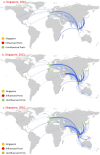How Does a Port Build Influence? Diffusion Patterns in Global Oil Transportation
- PMID: 36433192
- PMCID: PMC9695644
- DOI: 10.3390/s22228595
How Does a Port Build Influence? Diffusion Patterns in Global Oil Transportation
Abstract
Ports play a critical role in the global oil trade market, and those with significant influence have an implicit advantage in global oil transportation. In order to offer a thorough understanding of port influences, the research presented in this paper analyzes the evolution of the dominance mechanisms underlying port influence diffusion. Our study introduces a port influence diffusion model to outline global oil transport patterns. It examines the direct and indirect influence of ports using worldwide vessel trajectory data from 2009 to 2016. Port influences are modelled via diffusion patterns and the resulting ports influenced. The results of the case study applied to specific ports show different patterns and influence evolutions. Four main port influence trends are identified. The first one is that ports that have a strong direct influence over their neighboring ports materialize a directly influenced area. Second, geographical distance still plays an important role in the whole port influence patterns. Third, it clearly appears that, the higher the number of directly influenced ports, the higher the probability of having an influence pattern, as revealed by the diffusion process. The peculiarity of this approach is that, in contrast to previous studies, global maritime trade is analyzed in terms of direct and indirect influences and according to oil trade flows.
Keywords: direct influence diffusion; global oil transportation; indirect influence diffusion; ports; vessel trajectory data.
Conflict of interest statement
The authors declare no conflict of interest.
Figures













References
-
- Baştuğ S., Haralambides H., Esmer S., Eminoğlu E. Port competitiveness: Do container terminal operators and liner shipping companies see eye to eye? Mar. Policy. 2022;135:104866. doi: 10.1016/j.marpol.2021.104866. - DOI
-
- Dulebenets M.A. Multi-objective collaborative agreements amongst shipping lines and marine terminal operators for sustainable and environmental-friendly ship schedule design. J. Clean. Prod. 2022;342:130897. doi: 10.1016/j.jclepro.2022.130897. - DOI
-
- Ducruet C. Multilayer dynamics of complex spatial networks: The case of global maritime flows (1977–2008) J. Transp. Geogr. 2017;60:47–58. doi: 10.1016/j.jtrangeo.2017.02.007. - DOI
MeSH terms
Grants and funding
LinkOut - more resources
Full Text Sources

